
Sunrise (or sunup) is the moment when the upper rim of the Sun appears on the horizon in the morning. [1] The term can also refer to the entire process of the solar disk crossing the horizon.

Sunrise (or sunup) is the moment when the upper rim of the Sun appears on the horizon in the morning. [1] The term can also refer to the entire process of the solar disk crossing the horizon.

Although the Sun appears to "rise" from the horizon, it is actually the Earth's motion that causes the Sun to appear. The illusion of a moving Sun results from Earth observers being in a rotating reference frame; this apparent motion caused many cultures to have mythologies and religions built around the geocentric model, which prevailed until astronomer Nicolaus Copernicus formulated his heliocentric model in the 16th century. [2]
Architect Buckminster Fuller proposed the terms "sunsight" and "sunclipse" to better represent the heliocentric model, though the terms have not entered into common language. [3] [4]
Astronomically, sunrise occurs for only an instant: the moment at which the upper limb of the Sun appears tangent to the horizon. [1] However, the term sunrise commonly refers to periods of time both before and after this point:

The stage of sunrise known as false sunrise actually occurs before the Sun truly reaches the horizon because Earth's atmosphere refracts the Sun's image. At the horizon, the average amount of refraction is 34 arcminutes, though this amount varies based on atmospheric conditions. [1]
Also, unlike most other solar measurements, sunrise occurs when the Sun's upper limb, rather than its center, appears to cross the horizon. The apparent radius of the Sun at the horizon is 16 arcminutes. [1]
These two angles combine to define sunrise to occur when the Sun's center is 50 arcminutes below the horizon, or 90.83° from the zenith. [1]

The timing of sunrise varies throughout the year and is also affected by the viewer's latitude and longitude, altitude, and time zone. These changes are driven by the axial tilt of Earth, daily rotation of the Earth, the planet's movement in its annual elliptical orbit around the Sun, and the Earth and Moon's paired revolutions around each other. The analemma can be used to make approximate predictions of the time of sunrise.
In late winter and spring, sunrise as seen from temperate latitudes occurs earlier each day, reaching its earliest time near the summer solstice; although the exact date varies by latitude. After this point, the time of sunrise gets later each day, reaching its latest sometime around the winter solstice. The offset between the dates of the solstice and the earliest or latest sunrise time is caused by the eccentricity of Earth's orbit and the tilt of its axis, and is described by the analemma, which can be used to predict the dates.
Variations in atmospheric refraction can alter the time of sunrise by changing its apparent position. Near the poles, the time-of-day variation is exaggerated, since the Sun crosses the horizon at a very shallow angle and thus rises more slowly. [1]
Accounting for atmospheric refraction and measuring from the leading edge slightly increases the average duration of day relative to night. The sunrise equation, however, which is used to derive the time of sunrise and sunset, uses the Sun's physical center for calculation, neglecting atmospheric refraction and the non-zero angle subtended by the solar disc.
Neglecting the effects of refraction and the Sun's non-zero size, whenever sunrise occurs, in temperate regions it is always in the northeast quadrant from the March equinox to the September equinox and in the southeast quadrant from the September equinox to the March equinox. [6] Sunrises occur approximately due east on the March and September equinoxes for all viewers on Earth. [7] Exact calculations of the azimuths of sunrise on other dates are complex, but they can be estimated with reasonable accuracy by using the analemma.
The figure on the right is calculated using the solar geometry routine in Ref. [8] as follows:
An interesting feature in the figure on the right is apparent hemispheric symmetry in regions where daily sunrise and sunset actually occur.
This symmetry becomes clear if the hemispheric relation in to the sunrise equation is applied to the x- and y-components of the solar vector presented in Ref. [8]


Air molecules and airborne particles scatter white sunlight as it passes through the Earth's atmosphere. This is done by a combination of Rayleigh scattering and Mie scattering. [9]
As a ray of white sunlight travels through the atmosphere to an observer, some of the colors are scattered out of the beam by air molecules and airborne particles, changing the final color of the beam the viewer sees. Because the shorter wavelength components, such as blue and green, scatter more strongly, these colors are preferentially removed from the beam. [9]
At sunrise and sunset, when the path through the atmosphere is longer, the blue and green components are removed almost completely, leaving the longer-wavelength orange and red hues seen at those times. The remaining reddened sunlight can then be scattered by cloud droplets and other relatively large particles to light up the horizon red and orange. [10] The removal of the shorter wavelengths of light is due to Rayleigh scattering by air molecules and particles much smaller than the wavelength of visible light (less than 50 nm in diameter). [11] [12] The scattering by cloud droplets and other particles with diameters comparable to or larger than the sunlight's wavelengths (more than 600 nm) is due to Mie scattering and is not strongly wavelength-dependent. Mie scattering is responsible for the light scattered by clouds, and also for the daytime halo of white light around the Sun (forward scattering of white light). [13] [14] [15]
Sunset colors are typically more brilliant than sunrise colors, because the evening air contains more particles than morning air. [9] [10] [12] [15] Ash from volcanic eruptions, trapped within the troposphere, tends to mute sunset and sunrise colors, while volcanic ejecta that is instead lofted into the stratosphere (as thin clouds of tiny sulfuric acid droplets), can yield beautiful post-sunset colors called afterglows and pre-sunrise glows. A number of eruptions, including those of Mount Pinatubo in 1991 and Krakatoa in 1883, have produced sufficiently high stratospheric sulfuric acid clouds to yield remarkable sunset afterglows (and pre-sunrise glows) around the world. The high altitude clouds serve to reflect strongly reddened sunlight still striking the stratosphere after sunset, down to the surface.

A solar equinox is a moment in time when the Sun crosses the Earth's equator, which is to say, appears directly above the equator, rather than north or south of the equator. On the day of the equinox, the Sun appears to rise "due east" and set "due west". This occurs twice each year, around 20 March and 23 September.

Sunlight is a portion of the electromagnetic radiation given off by the Sun, in particular infrared, visible, and ultraviolet light. On Earth, sunlight is scattered and filtered through Earth's atmosphere as daylight when the Sun is above the horizon. When direct solar radiation is not blocked by clouds, it is experienced as sunshine, a combination of bright light and radiant heat (Atmospheric). When blocked by clouds or reflected off other objects, sunlight is diffused. Sources estimate a global average of between 164 watts to 340 watts per square meter over a 24-hour day; this figure is estimated by NASA to be about a quarter of Earth's average total solar irradiance.

In astronomy, an analemma is a diagram showing the position of the Sun in the sky as seen from a fixed location on Earth at the same mean solar time, as that position varies over the course of a year. The diagram will resemble a figure eight. Globes of Earth often display an analemma as a two-dimensional figure of equation of time vs. declination of the Sun.

A terminator or twilight zone is a moving line that divides the daylit side and the dark night side of a planetary body. The terminator is defined as the locus of points on a planet or moon where the line through the center of its parent star is tangent. An observer on the terminator of such an orbiting body with an atmosphere would experience twilight due to light scattering by particles in the gaseous layer.

Sunset is the disappearance of the Sun below the horizon of the Earth due to its rotation. As viewed from everywhere on Earth, it is a phenomenon that happens approximately once every 24 hours, except in areas close to the poles. The equinox Sun sets due west at the moment of both the spring and autumn equinoxes. As viewed from the Northern Hemisphere, the Sun sets to the northwest in the spring and summer, and to the southwest in the autumn and winter; these seasons are reversed for the Southern Hemisphere.

Dawn is the time that marks the beginning of twilight before sunrise. It is recognized by the appearance of indirect sunlight being scattered in Earth's atmosphere, when the centre of the Sun's disc has reached 18° below the observer's horizon. This morning twilight period will last until sunrise, when direct sunlight outshines the diffused light.
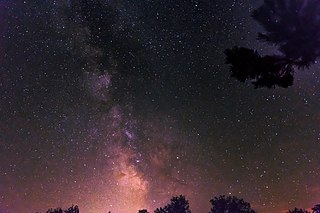
The sky is an unobstructed view upward from the surface of the Earth. It includes the atmosphere and outer space. It may also be considered a place between the ground and outer space, thus distinct from outer space.
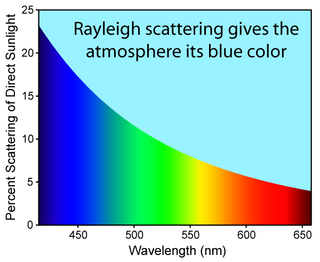
Diffuse sky radiation is solar radiation reaching the Earth's surface after having been scattered from the direct solar beam by molecules or particulates in the atmosphere. It is also called sky radiation, the determinative process for changing the colors of the sky. Approximately 23% of direct incident radiation of total sunlight is removed from the direct solar beam by scattering into the atmosphere; of this amount about two-thirds ultimately reaches the earth as photon diffused skylight radiation.
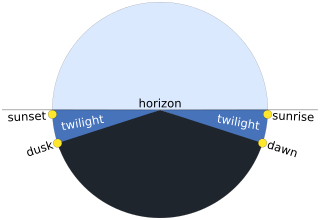
Twilight is light produced by sunlight scattering in the upper atmosphere, when the Sun is below the horizon, which illuminates the lower atmosphere and the Earth's surface. The word twilight can also refer to the periods of time when this illumination occurs.

A sunbeam, in meteorological optics, is a beam of sunlight that appears to radiate from the position of the Sun. Shining through openings in clouds or between other objects such as mountains and buildings, these beams of particle-scattered sunlight are essentially parallel shafts separated by darker shadowed volumes. Their apparent convergence in the sky is a visual illusion from linear perspective. The same illusion causes the apparent convergence of parallel lines on a long straight road or hallway at a distant vanishing point. The scattering particles that make sunlight visible may be air molecules or particulates.

The night sky is the nighttime appearance of celestial objects like stars, planets, and the Moon, which are visible in a clear sky between sunset and sunrise, when the Sun is below the horizon.

The blue hour is the period of twilight when the Sun is at a significant depth below the horizon. During this time, the remaining sunlight takes on a mostly blue shade. This shade differs from the colour of the sky on a clear day, which is caused by Rayleigh scattering.

The Belt of Venus is an atmospheric phenomenon visible shortly before sunrise or after sunset, during civil twilight. It is a pinkish glow that surrounds the observer, extending roughly 10–20° above the horizon. It appears opposite to the afterglow, which it also reflects.
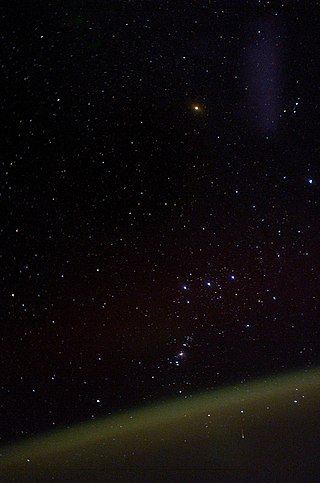
Sky brightness refers to the visual perception of the sky and how it scatters and diffuses light. The fact that the sky is not completely dark at night is easily visible. If light sources were removed from the night sky, only direct starlight would be visible.

Daytime as observed on Earth is the period of the day during which a given location experiences natural illumination from direct sunlight. Daytime occurs when the Sun appears above the local horizon, that is, anywhere on the globe's hemisphere facing the Sun. In direct sunlight the movement of the sun can be recorded and observed using a sundial that casts a shadow that slowly moves during the day. Other planets and natural satellites that rotate relative to a luminous primary body, such as a local star, also experience daytime, but this article primarily discusses daytime on Earth.

The color sunset is a pale tint of orange. It is a representation of the average color of clouds when the sunlight from a sunset is reflected from them.

The Rayleigh sky model describes the observed polarization pattern of the daytime sky. Within the atmosphere, Rayleigh scattering of light by air molecules, water, dust, and aerosols causes the sky's light to have a defined polarization pattern. The same elastic scattering processes cause the sky to be blue. The polarization is characterized at each wavelength by its degree of polarization, and orientation.
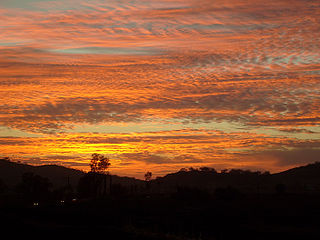
Atmospheric optics is "the study of the optical characteristics of the atmosphere or products of atmospheric processes .... [including] temporal and spatial resolutions beyond those discernible with the naked eye". Meteorological optics is "that part of atmospheric optics concerned with the study of patterns observable with the naked eye". Nevertheless, the two terms are sometimes used interchangeably.

Earth's shadow is the shadow that Earth itself casts through its atmosphere and into outer space, toward the antisolar point. During the twilight period, the shadow's visible fringe – sometimes called the dark segment or twilight wedge – appears as a dark and diffuse band just above the horizon, most distinct when the sky is clear.

Long-distance observation is any visual observation, for sightseeing or photography, that targets all the objects, visible from the extremal distance with the possibility to see them closely. The long-distance observations can't cover: